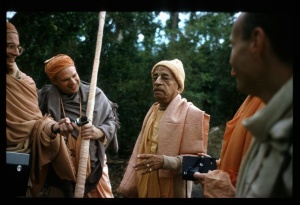CC Madhya 25.118 (1975): Difference between revisions
(Vanibot #0027: CCMirror - Mirror CC's 1996 edition to form a basis for 1975) |
(Vanibot #0020: VersionCompareLinker - added a link to the Version Compare feature) |
||
| Line 2: | Line 2: | ||
<div style="float:left">'''[[Sri Caitanya-caritamrta (1975)|Śrī Caitanya-caritāmṛta (1975)]] - [[CC Madhya (1975)|Madhya-līlā]] - [[CC Madhya 25 (1975)|Chapter 25: How All the Residents of Vārāṇasī Became Vaiṣṇavas]]'''</div> | <div style="float:left">'''[[Sri Caitanya-caritamrta (1975)|Śrī Caitanya-caritāmṛta (1975)]] - [[CC Madhya (1975)|Madhya-līlā]] - [[CC Madhya 25 (1975)|Chapter 25: How All the Residents of Vārāṇasī Became Vaiṣṇavas]]'''</div> | ||
<div style="float:right">[[File:Go-previous.png|link=CC Madhya 25.117 (1975)|Madhya-līlā 25.117]] '''[[CC Madhya 25.117 (1975)|Madhya-līlā 25.117]] - [[CC Madhya 25.119 (1975)|Madhya-līlā 25.119]]''' [[File:Go-next.png|link=CC Madhya 25.119 (1975)|Madhya-līlā 25.119]]</div> | <div style="float:right">[[File:Go-previous.png|link=CC Madhya 25.117 (1975)|Madhya-līlā 25.117]] '''[[CC Madhya 25.117 (1975)|Madhya-līlā 25.117]] - [[CC Madhya 25.119 (1975)|Madhya-līlā 25.119]]''' [[File:Go-next.png|link=CC Madhya 25.119 (1975)|Madhya-līlā 25.119]]</div> | ||
{{CompareVersions|CC|Madhya 25.118|CC 1975|CC 1996}} | |||
{{RandomImage}} | {{RandomImage}} | ||
==== TEXT 118 ==== | ==== TEXT 118 ==== | ||
<div class="verse"> | <div class="verse"> | ||
:māyātīta haile haya āmāra | :māyātīta haile haya āmāra 'anubhava' | ||
:ei | :ei 'sambandha'-tattva kahiluṅ, śuna āra saba | ||
</div> | </div> | ||
| Line 25: | Line 24: | ||
<div class="translation"> | <div class="translation"> | ||
" 'When one is transcendentally situated, he can perceive Me. This perception is the basis of one's relationship with the Supreme Lord. Now let Me further explain this subject matter. | |||
</div> | </div> | ||
| Line 32: | Line 31: | ||
<div class="purport"> | <div class="purport"> | ||
Real spiritual knowledge has to be received from revealed scriptures. After this knowledge is attained, one can begin to perceive his actual spiritual life. Any knowledge achieved by speculation is imperfect. One must receive knowledge from the paramparā system and from the guru | Real spiritual knowledge has to be received from revealed scriptures. After this knowledge is attained, one can begin to perceive his actual spiritual life. Any knowledge achieved by speculation is imperfect. One must receive knowledge from the paramparā system and from the guru, otherwise one will be bewildered, and will ultimately become an impersonalist. When one very scrutinizingly deliberates, he can realize the personal feature of the Absolute Truth. The Supreme Personality of Godhead is always transcendental to this material creation. Nārāyaṇaḥ paro 'vyaktāt: Nārāyaṇa, the Supreme Personality of Godhead, is always transcendental. He is not a creation of this material world. Without realizing spiritual knowledge, one cannot understand that the transcendental form of the Lord is always beyond the creative energy. The example of the sun and sunshine is given. The sunshine is not the sun, but still the sunshine is not separate from the sun. The philosophy of acintya-bhedābheda-tattva (simultaneously one and different) cannot be understood by one who is fully under the influence of the external energy. Consequently a person under the influence of the material energy cannot understand the nature and form of the Personality of the Absolute Truth. | ||
</div> | </div> | ||
Latest revision as of 16:04, 27 January 2020

A.C. Bhaktivedanta Swami Prabhupada
TEXT 118
- māyātīta haile haya āmāra 'anubhava'
- ei 'sambandha'-tattva kahiluṅ, śuna āra saba
SYNONYMS
māyā-atīta haile—when one becomes transcendentally situated above this external energy; haya—there is; āmāra anubhava—perception of Me; ei sambandha-tattva kahiluṅ—this has been explained as the principle of a relationship with Me; śuna—please hear; āra saba—all the rest.
TRANSLATION
" 'When one is transcendentally situated, he can perceive Me. This perception is the basis of one's relationship with the Supreme Lord. Now let Me further explain this subject matter.
PURPORT
Real spiritual knowledge has to be received from revealed scriptures. After this knowledge is attained, one can begin to perceive his actual spiritual life. Any knowledge achieved by speculation is imperfect. One must receive knowledge from the paramparā system and from the guru, otherwise one will be bewildered, and will ultimately become an impersonalist. When one very scrutinizingly deliberates, he can realize the personal feature of the Absolute Truth. The Supreme Personality of Godhead is always transcendental to this material creation. Nārāyaṇaḥ paro 'vyaktāt: Nārāyaṇa, the Supreme Personality of Godhead, is always transcendental. He is not a creation of this material world. Without realizing spiritual knowledge, one cannot understand that the transcendental form of the Lord is always beyond the creative energy. The example of the sun and sunshine is given. The sunshine is not the sun, but still the sunshine is not separate from the sun. The philosophy of acintya-bhedābheda-tattva (simultaneously one and different) cannot be understood by one who is fully under the influence of the external energy. Consequently a person under the influence of the material energy cannot understand the nature and form of the Personality of the Absolute Truth.